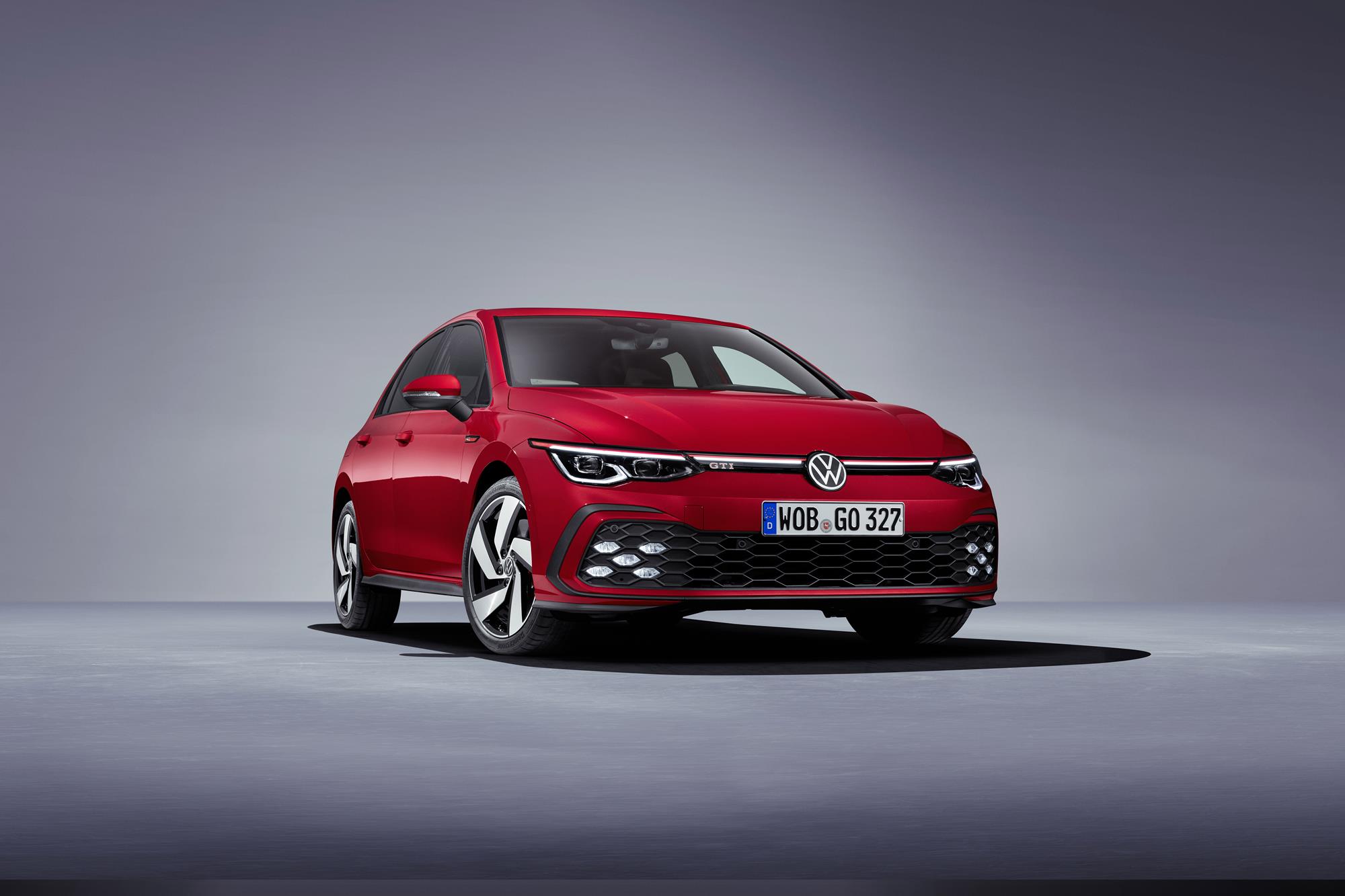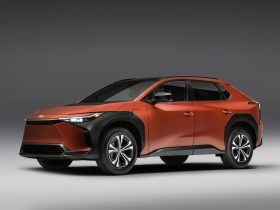It is important for an icon like the Golf GTI to evolve in order to cope with the march of progress. For 44 years, Volkswagen has been reinventing this sporty, compact-car icon while retaining the original concept. The eighth reinterpretation of the Golf GTI is now celebrating its debut. Newly designed and engineered, it is fully digitalized and networked. Put simply, it’s a Golf GTI that’s perfect for the modern era.
The Golf GTI Mark 1 from 1976 has since evolved into a vehicle family. The first GTI was followed in 1982 by the first Golf GTD with a turbocharged diesel engine, and in 2014 by the first Golf GTE that featured a plug-in hybrid drivetrain. So it makes perfect sense that the new Golf GTD and Golf GTE are celebrating their world premières alongside the new Golf GTI. Three Golf variants, three characters, three efficient and clean drive systems—but one design philosophy.
GTI. The new Golf GTI is an agile, raw, efficient and high-tech compact sports car for the digital age, with 245 horsepower (180 kW).
GTE. With an identical output of 245 hp, the new Golf GTE is just as powerful as the Golf GTI. The hybrid drivetrain is designed for sporting performance and combines electrical sustainability and zero-emissions range of around 37 miles (60 kilometers) with great dynamic performance.
GTD. The new Golf GTD is a real endurance athlete. In this variant, an output of 200 hp (147 kW) has been coupled with very long range between refueling.
EXTERIOR
Dynamic front end. The design of the new, sporty Golf models is charismatic. The standard LED headlights are positioned low down and form a striking crossbar in conjunction with the radiator grille. Towards the top of the hood, a narrow line spans the front end—red in the case of the GTI, blue for the GTE and silver for the GTD.
Once the daytime running lights are activated, such as when the driver approaches with the key, an LED strip in the headlight mirrors the red, blue or silver line. As standard, the radiator grille is illuminated as a continuation of the LED strip for the first time. This creates the completely new, unmistakable headlight design of the Golf GTI, GTE and GTD.
Another striking and unmistakable feature is the typically large, honeycomb-pattern one-piece lower air intake grille. It is framed on the outside by black applique, with a striking wing-like design on the sides. The new GTI insignia also include the optional foglights which are now integrated in an X-shape into the air intake grille.
The side profiles features the eye-catching, standard 17-inch Richmond aluminum-alloy wheels, unique to the GTI. Optional 18-inch or 19-inch rims are available. The brake calipers on the new, sporty Golf models are painted red. The GTI and GTD also carry a badge with their respective lettering on the side of the front fender. The GTE instead has a cover on the passenger side for charging the battery. All three models feature wider side skirts sills in black and a race-car-style splitter design. A spoiler extends the roof line at the back of the car. The dominant design element of the side section is the characteristic Golf C-post that visually propels the vehicle body forwards and transposes the iconic graphics of the original Golf and GTI into the modern era.
The new Golf has a powerful shoulder section and striking rear end design, with LED taillight clusters as standard. The GTI, GTE or GTD lettering is now positioned centrally under the Volkswagen emblem rather than on the driver side as it was previously. At the bottom, the sporty diffuser also distinguishes the new cars from the other Golfs. They are also differentiated by the exhaust tailpipes—the GTI has one tailpipe on the left and one on the right, the GTD has a double tailpipe on the left, and there is no tailpipe in sight on the GTE.
INTERIOR
Right from the outset, Volkswagen created distinctive, dynamic interior design with the multitude of details—the sport steering wheel featuring three silver double spokes and recessed Wolfsburg emblem, the golf ball shifter knob and tartan GTI sport seats.
Although Volkswagen is enhancing the digital and networking capabilities of the eighth-generation Golf to an unprecedented extent in order to future-proof the range, many of the classic details can still be found on board. However, the sport steering wheel of yesteryear has been transformed into a new multifunction leather sport steering wheel with touch controls and an available Travel Assist button to help the powerful Golf models reach a top speed of 130 mph while Travel Assist is engaged.
The three silver spokes have been retained, with a red central spoke for the GTI, blue for the GTE and silver for the GTD. The classic plaid covering for the sport seats is also kept, but in a new checked design called Scalepaper. The seams of the gray and black design are red in the GTI, blue in the GTE and light grey in the GTD. Red, blue or black are also used for all decorative seams and edging, depending on the model.
The Innovision Cockpit extends upwards upon opening the doors in the Golf GTI, GTE and GTD. It is a fusion of the top-of-the-range version of the 10.25-inch Digital Cockpit and the 10-inch navigation system. The visual and functional blend of the two screens creates a new and consistent digital architecture.
The background lighting, which also comes as standard, embeds the displays and all other illuminated interior areas (dash panel, door trim, storage compartment with interface for mobile telephone, footwell) in a spectrum of 30 configurable colors. The Golf GTI, which is equipped with a 6-speed manual gearbox as standard, features a brand new GTI shifter knob. The GTI is available with an optional, automatic 7-speed dual-clutch automatic transmission (DSG); the GTD comes exclusively with this DSG. The GTE features a 6-speed DSG developed for the hybrid drivetrain. The functionality of the standard start/stop button has been customized—once the doors have been opened, it pulses red until the drive system has been started.
STANDARD EQUIPMENT
In general, every new Golf is fitted with assist systems including the Lane Assist lane keeping system, Front Assist (Autonomous Emergency Braking with Pedestrian Monitoring), the XDS® electronic differential lock and Car2X (local communication with other vehicles and the traffic infrastructure).
Standard digital instruments and an infotainment system have been designed to suit the mobile We Connect and We Connect Plus online services and functions that have been integrated here. Other standard features include the multifunction steering wheel, single-zone automatic climate control (Climatronic), the Press & Drive comfort start system, LED headlights, LED taillights, LED daytime running lights, LED reading lights and two USB-C ports. The cars all feature stainless-steel pedal covers.
On the exterior, the equipment is supplemented by the 17-inch aluminum-alloy wheels, the rear diffuser, roof spoiler, individualized tail pipes, red brake calipers and sill extensions. The GTI and GTD have a 0.6-inch lower sport suspension than a standard Golf.
DRIVETRAINS
GTI. The new Golf GTI is powered by an EA888 evo4 245-hp 2.0-litre turbocharged and direct injection four–cylinder engine. The maximum torque is 273 pound-feet (370 Nm). The four-cylinder engine is coupled with a 6-speed manual gearbox (MQ350) as standard. A 7-speed dual-clutch gearbox (DQ381 DSG) is available as an option.
GTE. The plug-in hybrid drivetrain consists of an EA211 150-horsepower 1.4-litre turbocharged engine, a 114-hp (85 kW) electric motor, a 6-speed DSG (DQ400e) and a new lithium-ion battery. The powertrain delivers a maximum power output of 245 hp (180 kW) and a maximum system torque of 295 lb-ft (400 Nm). Compared with its predecessor, the all-electric range has increased significantly to now around 37 miles (60 km).
Volkswagen’s engineers have achieved the range increase by improving the Golf’s aerodynamics and managing to increase the energy content of the battery by 50 percent to 13 kWh. It can be driven at speeds of up to 81 mph in all-electric mode. When the battery is sufficiently charged, the Golf GTE always starts in all-electric E-MODE. The drive switches to Hybrid mode if the energy capacity of the battery drops below a certain level or if the speed rises above 81 mph.
In Hybrid mode, the driver has the option of maintaining the state of charge using three symbols on the Infotainment screen (the equal sign “=”), increasing it (up arrow “Ù”) or reducing it to a defined level (down arrow “Ú”). This makes it possible to drive into the city under electric power and with zero emissions, even at the end of a longer journey.
Whenever route guidance is active in the navigation system, the battery manager also predictively takes into account road and topographical data to ensure the set battery energy is available when you reach your destination. During this process, battery use is adapted on the basis of the route data in order to achieve an optimum electrical range.
GTD. The long-range sporty Golf features an EA288 evo series 2.0-litre, four-cylinder turbocharged diesel engine (TDI) with an output of 200 hp (147 kW) and 295 lb-ft of torque. As with all the turbocharged diesel engines in the new Golf, the GTD’s drive system is linked to two SCR catalytic converters with dual AdBlue injection to greatly reduce nitrogen oxide emissions compared with its predecessor. Volkswagen offers the Golf GTD with a 7-speed dual clutch gearbox (DQ381 DSG) as standard.
RUNNING GEAR
Volkswagen has developed and perfected the running gear of the Golf GTI, GTE and GTD with the combination of a strut-type front and a multi-link rear suspension. A new driving dynamics control system known as the Vehicle Dynamics Manager is used for the first time. The system controls both the XDS function and the lateral functionality of the DCC adaptive damping system, which is optional on the European car.
The DCC system continuously reacts to the road surface and driving situation while taking account of steering, braking and acceleration inputs. The required damping is calculated for each wheel and adjusted at the four wheels within fractions of a second. Consequently, DCC always provides the highest level of driving comfort and ensures ideal driving dynamics in combination with the driving dynamics manager.
In the latest DCC system, the vehicle setup can be extended in INDIVIDUAL mode to go beyond the existing range of the fixed COMFORT, ECO and SPORT modes. The driver can accurately set and store their personal driving profile using a digital slider. Beyond the COMFORT setting, the body is “decoupled” from the road surface as much as possible, thus boosting driving comfort. Beyond the SPORT setting, there is an extended range with maximum damping for minimized body movements and extremely direct handling for that unadulterated GTI, GTD and GTE feeling.







